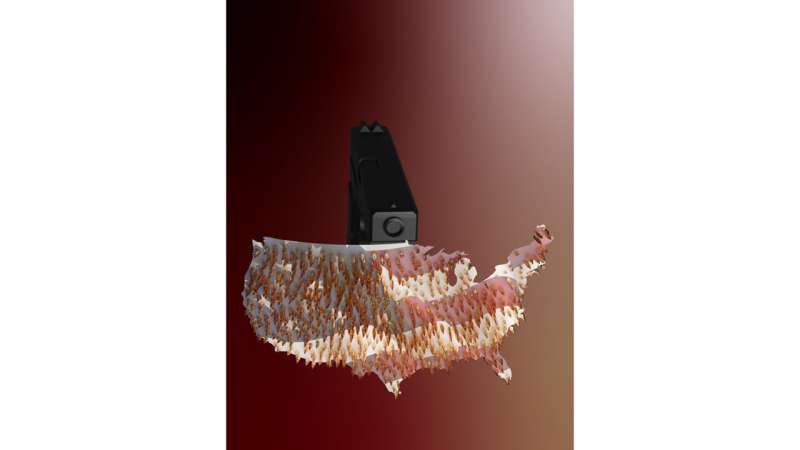Synchronization of firearm background check data reveals acquisition patterns

How has gun background check data—an accepted proxy of firearm sales—trended during the past 20 years?
In the journal Chaos, researchers from New York University and Northeastern University explore the factors driving background checks, whether coordination between U.S. states may exist, and if one state exerts any influence over others in terms of enacting gun laws or acquiring firearms.
Such an undertaking required new mathematical tools and statistical methods to study collective dynamics, network systems, and causal associations from time series. The researchers constructed a reliable, rigorous mathematical approach to interpret the patterning of firearm background check data.
To do this, they used a quantification of synchronization as a proxy for inferring possible coordination between states.
"From a first look at the background check data, we observed rich patterns of annual and high-frequency oscillations throughout the U.S.," said Rifat Sipahi, from Northeastern University. "Oscillations between states may be in phase or out of phase, with the former class defining synchrony and coordination among the states, and the latter pointing to disarray among them."
Surprisingly, they found these patterns of frequency oscillations are different at various time points. This suggests states may have interacted differently with each other during the terms of former Presidents George W. Bush, Barack Obama, and Donald Trump.
While the researchers do not address political science or sociology in their paper, their results can provide further insights into these research domains.
"Specifically, our results can help explain the behavior of U.S. citizens toward firearm acquisition in different states at different times," said Maurizio Porfiri, from New York University.
For example, loss of synchronization among the U.S. states during Obama's first term in 2010-2011 follows the aftermath of one of the most significant financial crises. The consequences of this crisis must have been felt differently in different states, which may be one of the contributors to the loss of synchronization.
They discovered a pronounced loss of synchronization after 2018, which coincides with Trump's term. Even after ignoring the COVID-19 pandemic, this loss of synchronization was dramatic.
"While we cannot make causality claims, it is likely that political, social, legal, and economic climates within the U.S. during (Trump's) term had some effect on the behavior of citizens toward firearm acquisition," Sipahi said. "Equally important, high-frequency oscillations in the background check data present similar patterning between Obama's and Trump's first term—indicating similar response of citizens toward firearm acquisition."
It is critical to note these interpretations do not imply loss of synchronization is caused by a sitting president or vice versa. It may imply that synchronization varies during a presidential term due to many factors, which influence similarly or differently the U.S. citizens within different states toward firearm acquisition.
Synchronization is one of the most important concepts involved in this work.
"In a nutshell, if we consider two states with oscillating background check data, we would say these are perfectly synchronized if their oscillations are perfectly in phase—meaning they oscillate up and down at the same time," said Porfiri. "Obviously, the real world is far from ideal, and perfect synchrony does not exist. So we quantified the degree of synchronization by the 'Kuramoto order parameter' for annual oscillations in the background check data."
As they plotted the synchronization degree over time, they discovered the states have been highly synchronized during the last 20 years, except during 2010-2011 and after 2018.
"Synchronization has some temporal characteristics, which complements prior evidence that pointed out spatial patterns in firearm acquisition in the U.S. Its highs and lows may depend on the geographic location of the state," Sipahi said.
The article was published in Chaos.
More information: Rifat Sipahi et al, Spatio-temporal patterns of firearm acquisition in the United States in different presidential terms, Chaos, 2022. DOI: 10.1063/5.0096773
Journal information: Chaos
Provided by American Institute of Physics


















